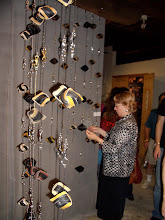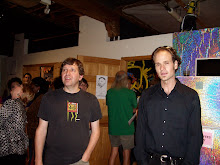The Installation of Three Knots, Two Spheres, and a Mirror
RECLAMATION @ Hermitage Museum & Gardens
Location: The Hermitage Museum Hallway, downstairs
Spheres.
Two pieces that I was
determined to make for Reclamation were two Tirespheres, on each for the two
woodcarvers, who devoted copious amounts of time, sweat and passion to
enlivening every facet of the Sloanes’ house with their artistry.
SPHERE FOR WOODSEND
The first tiresphere I wanted
to make for Charles Woodsend, a master woodcarver living in the area who the
Sloanes had connected with, and contracted to not just ‘wittle’ the house,
Woodsend actually BUILT the house! And remodeled it several times, including
turning the whole thing around! THEN, of course, he proceeded to incorporate
his many fine features into the architecture of the place, finally inscribing
on the wall above a window (at Mrs. Sloanes direction, to be sure) something
like “Art is simply about doing things the right way”
(GET ACTUAL QUOTE)
The second tiresphere was to
be for Rydingspar, a Scandenavian woodcarver who came to work with on the house
with Charles Woodsend. Rydinspar had a style which was more fluid and gothic
than Woodsends, who, perhaps as a builder, made more rectaliniar pieces to
harmonize with the house that he had built. Rydingspar added some interesting
hounds and gargoyle like figures.
(GET RHYDINGSPAR’s FULL NAME)
To honort these two artists,
I wanted to create a sphere for each of them, reflecting their own personal
style.
For Woodsend, I wanted to
make a sphere that reflected the man, his style and his work.
I knew that I wanted it to be
somewhat rectilinear, relying on the right of angles at the joints of a
tireshpere’s perbindicularly intersecting tires to help express this. I had
brought with me a basic tire sphere, which I had considered using, particularly
if I got caught on time. However, as the weeks wore on, I just didn’t feel good
about it. It seemed somehow in sufficient. Fortunately, I was able to leave
myself enough time at the end to really concentrate some attention on this
piece, and when that time came, it became clear to me, that I would need to
start from scratch. Otherwise, I might have the ghost of Charles Woodsend,
rattling his chains at me forever more (which he had been practicing to good
effect for the past 4 weeks). So I had myself another beer, and got down to it.
First, I though it should be
more robust. Charles Woodsend was a big burley bear of a man from the looks of
him in a painting. Kind of a John Bonham. So I selected a few ‘3-sets’ of mountain bike tires that I had brought
from NC to choose from, finally settling on a hybrid tire with a nice warm
brown sidewall, with the fabrics weave showing, and a nice smooth finnish on
the tread, reflecting well the smoothness and finish of Woodsend’s woodwork
inside the house. This was a great start. In a way, it represented Woodsend the
builder. But I knew that it needed more. After all Woodsend was not just a
builder, but an artist as well. In the words of an Irish sailer I met at a bar
in Norfolk, he was both ‘form and function’. So I decided that I would attempt
something that I never had before, and that was to add another ‘tier’ to the
sphere. An intierior sphere, in
the tiresphere. For this, I selected another ‘3-set’, this time a thinner road
bike tire, a nice ‘armadillo’, with a dark rich red sidewall. A set of these
can make a really nice and salable sphere, and I must admit I was alittle bit
weary of risking these for this experiment, as I was not at all sure that it
would work… RATTLE RATTLE, Woodsend wailed away on those chains, and so further
on, into the night, and into new territory in my tire craft I plodded.

And when day broke, I finally
had a Tiresphere worthy of hanging
in the house that this man had built with his hands.
RHYDINGSPHERE
My next task, of course was
to build a sphere for Rhydinspar, the Scandenavian woodcarver, who came on work along side Woodsend at his work on the house.
This one I thought would be
fun, as, again, Rydingspar had a much more fluid, gothic approach. I had
created an ‘Irisphere’ several years ago, which Melanie, the Director of the
Museum, had really adored, and wanted me to include. The very organic shapes
created by tying these tires together in the way that they are is very
evocative of plant life to me, and I thought that it at least began to approach
Rydingspar’s style, quite well actually.
The only problem
with including this piece, was that I had originally created it as an
experiment, and it was still in somewhat of an experimental state. For
instance, all of the tires were bound together with zip ties. Of course, this
wasn’t acceptable for presenting in a museum. But to replace them with another
fastener would have been an exacting process, as I had not been carefull and methodical in marking the places
for the connections, and then it was destined to be a bit wonky.
So finally, I
realized that the only thing left to do, was to rebuild it, from the ground up,
using a new group of tires.
I searched through the pile
that I had brought and amassed, and fortunately, was barely able to find 6
black tires of the same size!
And so I was off!
It had probably been 4 years
since I had made that thing, but once I dug in, I began to remember how it all
worked, and what a marvelous being this sphere is.
The beautiful thing about the
Irisphere is that it is actually two sets of three tires, one inside of the
other, each holding the other in place. The openings between the tire are
created by pulling these two sets against themselves, towards eachother,
somewhat against their own will God, there has got to be some fascinating
allegory of relationships in there, but I don’t know what it is yet. (Maybe an
arranged marriage?) But the point is that the form is under a dynamic tension,
and I decided that I wanted to bring that out and show it a little.
And so I used some left over
scraps of ball chain to bind these parts together, in their unfortunate
marriage. You can these two sphere, yearning to return to themselves, by the
tension put on this chain, which stretches straight and alert. I found the
effect to be quite a bit more telling (and visually pleasing) than those ugly
zip ties. But I didn’t stop there. What, I wondered, if the inner sphere showed
itself, as its own sphere, suspended in this marriage to the larger sphere? The
plot thickens!
Well the end result is not
meant to be any kind of comment of Rydingsphar’s family life (of which I know
nothing), but it did come out to be a damned interesting form!
And while it is actually a
little TOO curvy for Rydingsphar’s style, which combined these curves with
points, these points can be found, interestingly, not in the actuall form, but
in its appearance, when the viewer looks through the form. All in all, I would call this piece mostly
successful.
These two spheres we hung in
the main hallway of the museum downstairs, infront of two large windows. These
windows had a nice grid of steel which I thought complimented the ‘moving’
black bands of the tires. The light shining through also added to the gothic
aspect of these forms, particularly Rydingsphar’s, which sort of took on the
look of stained glass, and the ornate bas reliefs that he had carved above the
window.
Woodsend also built the water
tower that you see on your left hen you enter the museum gate. It was here that
he had his studio. One day, Colin Firth, the Interpreter of the Museum, agreed
to show me the space. Unfortunately, it turned out that his tools had been
removed. But Colin did show me the inside of the tower, which was structure to
behold.




